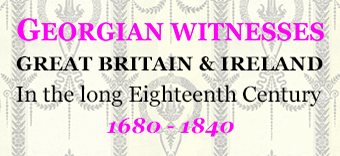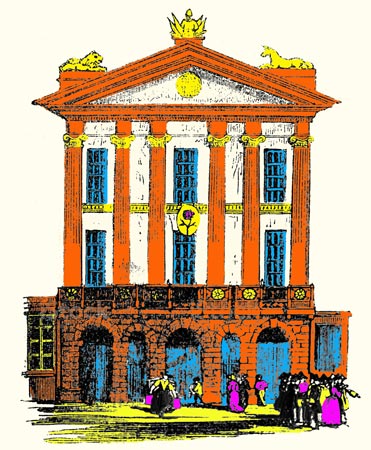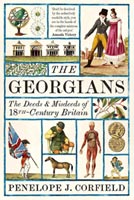Georgian Witnesses
18 / APPRECIATING GEORGIAN URBANISATION VIA NOTABLE BUILDINGS AND STREET SCENES THAT SURVIVE TODAY
CONTEXT
The following Georgian features provide a flavour for the urban explorer –and there are always more legacies to detect.
18.1 NINE GEORGIAN ASSEMBLY ROOMS
Bath (1771)
Belfast (1776)
Edinburgh New Town (1783 – 7)
Leeds (1777)
Liverpool Wellington Rooms (1815 – 16)
Norwich Assembly House (1754)
Nottingham Old Assembly Rooms (C18; remodelled 1790; 1836)
Stamford (1727)
York (1731/2)
18.2 NINE NOTABLE GEORGIAN TOWN HOUSES
Aberdeen: James Dun’s House (1769) and Museum
Bath: No. 1 Royal Crescent
Bristol: Georgian House, Great George Street
Chichester: Pallant House & Art Gallery
Dublin: Number 29, Georgian House Museum
Edinburgh: Georgian House, Charlotte Square
Hull: Wilberforce House, High Street
London: Apsley House, Piccadilly
London: Dennis Severs’ House, Folgate Street, E1
18.3 NINE GEORGIAN MARKET HOUSES OR MARKET CROSSES
Many Georgian towns built market meeting-houses or specialist exchange buildings; but the best surviving examples tend to be found in smaller towns, while those in larger places have either been rebuilt or lost to later redevelopment.
Armagh, Co. Armagh: Market House (1815), now Library
Barnard Castle: Market Cross (1747)
Beverley: Market Cross (1714)
Cahir, Co. Tipperary: Market House (c.1770), now used as Library
Durley, Gloucestershire: Market House (1738)
Halifax: Piece Hall (1779), grand Palladian textile exchange
Ludlow: Buttercross (1746)
Monaghan, Co. Monaghan: Market House (1792), now Arts venue
Swaffham, Norfolk: Market Cross (1781 – 3)
Extra: An example of repeated rebuilding Manchester’s first commercial Exchange was opened in 1726; a second dated from 1809; and the third (built 1867 – 74) is now Manchester’s Royal Exchange Theatre.
18.4 NINE GEORGIAN TOWN HALLS
Note that some of these buildings had arcaded ground floors, where market business was transacted, their roles thus sometimes overlapping with Market Houses (above 18.3)
Aberdeen: Old Town House (1788 – 9), now University museum
Bath: Guildhall (1775 – 8; with later extensions)
Berwick-upon-Tweed: Town Hall (1754 – 60)
Kilkenny, Co. Kilkenny: The Tholsel or City Hall (1761)
Liverpool: Town Hall (1749 – 54; extended 1795)
Maidstone: Old Town Hall (1753)
Musselburgh, East Lothian: Town House (1733), next to medieval Tolbooth
Newark-on-Trent: Town Hall (1776)
Whitchurch, Hampshire: Town Hall (1712)
18.5 NINE GEORGIAN URBAN STREET SCENES
Bath: centre incl. Circus (1754) + Royal Crescent (1767/75)
Beverley: North Bar Within + North Bar Without, ‘Georgian quarter’
Blandford Forum: Market Place (rebuilt post 1731 fire)
Birr, County Offaly: Irish Heritage Town with Georgian centre
Chichester: pedestrianised city centre, many Georgian houses
Farnham: centre for Georgian brick houses, some built upon older cellars
Ludlow: town centre
Stamford: town centre + market (much C18)
Tunbridge Wells: Pantiles (1700 Upper Walk repaved) + adjacent area
18.6 NINE GEORGIAN TOWN WALKS OR PROMENADES
Many places had communal ‘walking areas’ where people gathered to stroll, such as by a river or the sea, whether or not there were formal pathways. In addition, from the late eighteenth century onwards, seaside towns also built piers to encourage social promenading and shared entertainments, as well as to land visitors arriving by sea. Another variant was a specialist arcade for smart shopping and walking.
Bath: The Corridor (1825), covered retail arcade
Bristol: The Arcade (1825) between Broadmead + Horsefair
Cheltenham: The Promenade (1818)
Chester: Old City Walls (popular walking route in C18)
King’s Lynn: The Walks (eighteenth century), now also name of adjacent park which is home to KL Town Football Club
Leicester: New Walk (1785)
London: Burlington Arcade (1818)
Norwich: Gentleman’s Walk (fashionable side of central market)
York: New Walk (1730s), by
River Ouse
18.7 NINE GEORGIAN THEATRES
Bath: Theatre Royal (1805)
Bristol: Theatre Royal (1764 – 6), now Bristol Old Vic
Dumfries: Theatre Royal, initially known as New Theatre (1792)
Lancaster: Grand Theatre (1782; remodelled 1897; 1908)
London: Theatre Royal, Drury Lane (1812)
London: Theatre Royal, Haymarket (1720)
Margate: Theatre Royal (1787; remodelled 1874)
Richmond, N. Yorkshire: Georgian Theatre Royal (1788)
York: Theatre Royal (1744)
18.8 NINE GEORGIAN ARTISTS WHO PAINTED TOWNSCAPES
None specialised exclusively in town views; but the following, British-born and one eminent Italian visitor, included Georgian townscapes among their repertoire (here excluding graphic satirists like Hogarth and Rowlandson).
Giovanni Canaletto (1697 – 1768)
John Crome (1768 – 1821)
Thomas Girtin (1775 – 1802)
Joseph Farington (1747 – 1821)
Alexander Nasmyth (1758 – 1840)
George Pyne (1801 – 84)
Michael Angelo Rooker (c.1746 – 1801)
Paul Sandby (1730 – 1809)
Joseph Mallord William Turner (1775 – 1851)
SURVIVING URBAN VENUES OF SPECIAL INTEREST FOR APPRECIATING GEORGIAN SOCIETY IN THE ROUND
18.9 Berwick-upon-Tweed: Barracks and Main Guard, on Parade, Berwick-upon-Tweed TD15 1DF, now English Heritage Museum, located in purpose-built barracks (1717-21; and later additions) and including display ‘By Beat of Drum’, featuring the life of the ordinary infantryman in C18/C19. See:
www.english-heritage.org.uk/visit/places/berwick-upon-tweed-barracks
18.10 Birmingham Back-to-Backs: Hurst Street, Birmingham B5 4TE, preserved as museum by National Trust as early C19 exemplars of very poor high-density urban housing, extensively built from 1790s onwards, in industrial towns such as Birmingham, Leeds, Sheffield, despite repeated protests that these dwellings were cramped, insanitary and badly ventilated. See: www.nationaltrust.org.uk/
birmingham-back-to-backs
18.11 Chatham: Historic Dockyard, Chatham Main Gate Road ME4, constitutes the most complete dockyard of the Age of Sail. Things to see include Administrative Offices, the Ropery, and the Smithery, plus displays of paintings, models and artefacts, including a model of Chatham Dockyard presented to George III in 1774. See:
https://thedockyard.co.uk
18.12 Greenwich: The Fan Museum (opened 1992), located at 12 Crooms Hill, London SE10 8ER: celebrating the history of fan-making, the use of fans, which were commonly used in Georgian Britain, especially but not exclusively among well-to-do women; and showing exhibits from around the world. See: www.thefanmuseum.org.uk
18.13 Inveraray: Jail at Inveraray, Argyll, is a stone-built Courthouse and Prison (1820), which is now a tourist attraction, giving visitors the opportunity of exploring the buildings and confronting the prison experience, with interpreters re-enacting individual stories from the past. See: www.visitscotland.com/info/see-do/inveraray-jail
Compare for scale with the various surviving C18 stone- or brick-built village lockups, holding one or two offenders overnight, awaiting their appearance before magistrates. See:
https://en.wikipedia.org/wiki/
Village_lock-up
18.14 Lancaster: Cottage Museum, 15 Castle Hill, facing Lancaster Castle, Lancaster LA1 1YN, is located in a 1739 house, sub-divided in 1820, and furnished in the style of an artisan household of that date. Offers full immersive experience of daily life, including household labour and family recreations. See: https://www.lancaster.gov.uk/sport-and-leisure/museums/cottage-museum
18.15 London: Foundling Hospital Museum, Brunswick Square WC1N, housed in the original Foundling Hospital (opened 1741), the museum has key collections relating to the children aided by the charity; to the benefactors; and to the musician Handel, who was a strong supporter. For details, see: https://foundlingmuseum.org.uk
18.16 London: Sir John Soane’s Museum, 13 Lincoln’s Inn Fields, London WC2A 3BP, housed in the home of neo-classical architect, Sir John Soane (1753-1837), as he bequeathed it to the nation (1837), the museum offers an extraordinary immersion in his collection of paintings, drawings, sculptures, antiquities and architectural models. For details, see:
www.soane.org – restricted entry
18.17 Waterford: Bishop’s Palace (built 1741), located in The Mall, Waterford X91 E279, Ireland, with display of Waterford Treasures, notably Waterford glassware from the eighteenth century and after, including a decanter (1789) which is the oldest surviving piece of Waterford Crystal, plus a further range of exhibits and paintings illustrative of Waterford’s history from 1700 to the 1970s. See:
www.waterfordtreasures.com/
bishops-palace




